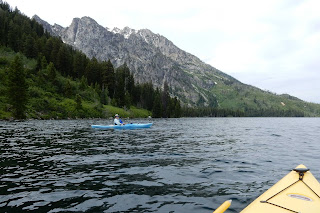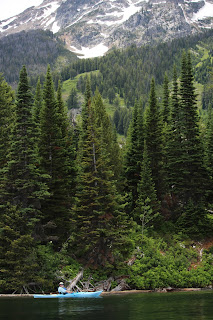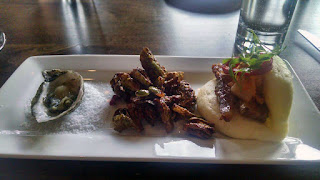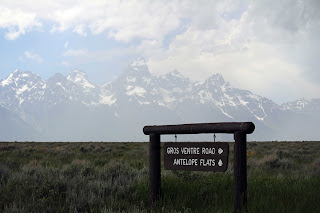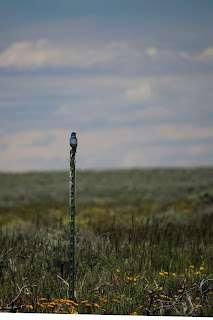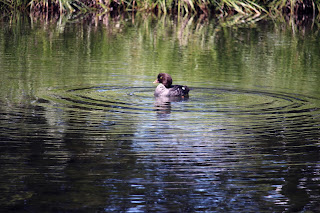Hope you enjoyed
our last blog post highlighting our adventure in the south entrance to Yellowstone
National Park. This blog post is about everything else we did in the month of
June during our stay at the Grand Teton Park RV Park in Moran, WY. There was never a dull moment!
Grand
Teton National Park
Few landscapes in
the world are as striking and memorable as that of Grand Teton National Park. While
Grand Teton rises 13,770 feet abruptly from the valley floor, the Tetons offer
a testament to the power and complexity of nature. The mountains, valleys, lakes,
rivers and skies are home to diverse and abundant plants and animals. It is a
place to observe wildlife and scenery, enjoy the peacefulness and appreciate
the conservation management of these lands.
This spectacular
mountain range and the desire to protect it resulted in the establishment of
Grand Teton National Park in 1929. Through the vision of and generous
philanthropy of John D. Rockefeller, Jr., additional lands were added, creating
the present day park in 1950.
Moose-Wilson
Corridor
We decided to take
a drive through the Moose-Wilson Corridor, a 10,300 acre corridor in the
southwest corner of Grand Teton National Park.
Moose Wilson Road dissects the corridor and is the primary access to
canyons, preserves, trailheads and historic districts. The drive on this narrow
scenic road was beautiful and provides outstanding wildlife viewing
opportunities. We encountered a cow moose with her calf just outside our
windows.
Kayaking
on Jenny Lake
There are grizzly
bears and black bears in Yellowstone and Grand Teton so Sharon was reluctant to
hiking or kayaking. Especially since a
park ranger was killed by a grizzly bear while hiking alone! It is advised that you hike in groups of 3 or
more. But being the outdoorsman that he is, Mike talked Sharon into kayaking on
Jenny Lake in Grand Teton National Park! Sharon had no regrets, as kayaking
along the Teton Range on Jenny Lake was awesome! Cascade Canyon was the
prominent feature of the Teton Range.
After we secured
the kayaks atop the Jeep, we stopped at a pull-out to see the lake from a different perspective!
Scenic
Float Trip on the Snake River
We have experienced
whitewater rafting on the Pacuare River in Costa Rica with Class 4 rapids. We
also enjoyed rafting with the Nantahala Outdoor Center down a rock and roll
section of the Ocoee River in Tennessee. In addition, Mike did a guy trip and
kayaked on the Class 3 section of the Chattooga River in Georgia (most
recognized for its depiction in the film “Deliverance.”
Since we’ve been
there and done that, today we decided to take a 13-mile “scenic float” down the
Snake River. We started our day with a Boatman’s Breakfast of burritos,
muffins, oatmeal, fruit, coffee and juice at the Mad River Boathouse in Jackson
Hole. We departed by van, raft in tow and headed to the river 2 miles south of
town where we launched the 18’3” raft at the Wilson Bridge Boat Ramp.
With our camera
and binoculars we joined our guide and four other people to experience a trip
through braided river channels and sand bars, along pristine landscape. While our guide navigated through mild rapids
he shared the history, geology and wildlife of the region. We especially enjoyed the eagles perched in
trees along the way!
JACKSON
HOLE
The
Jackson Hole Food Tour
We can’t pass up a
food tour for a unique culinary experience wherever we go. What better way to
sample the food of local restaurants and the history of the town. Clarke Todd,
co-founder and co-owner of The Jackson Hole Food Tour was our guide on June 20
that took us to Bin 22, Café Genevieve, Lotus Café, Sweetwater Restaurant,
Gather and Persephone Bakery!
We met at Bin 22
where we enjoyed a glass of wine!
From there we
walked to Café Genevieve located in a historic log cabin and enjoyed a sampler
plate of pork belly wraps, Brussels sprouts and biscuits with ham and other
toppings. To drink we sipped on the signature cocktail, the Cochon, made with a
mix of bourbon, maple syrup and Cointreau liqueur with candied bacon on the rim
of the glass. Yummmm!
Next, we walked
amongst the tourists through Jackson Hole Square to Sweetwater Restaurant where
we enjoyed outdoor seating. Here we all went for seconds on the pork tenderloin.
Our bellies were
already getting full, but we pushed on to the next restaurant called Gather
where we delighted their spicy signature limeade caliente cocktail made with Jalapeno
Tequila. It was so delicious we bought some Jalapeno Tequila later on in our
trip! Mike ate Sharon’s oyster, but we both enjoyed the Brussels sprouts and candied
bacon, and a savory pork dumpling! To die for!
At the Lotus Café
we enjoyed an unusual, but tasty organic salad accompanied by a prickly pear
concoction.
Finally, a meal is
not complete without dessert so we stopped at the Persephone Bakery and enjoyed
a cup of coffee and a trio of heavenly desserts!
It was a decadent
day of culinary delights! And our guide, Clarke made it an interesting and
light-hearted affair! We enjoyed the food tour immensely and would highly
recommend it if you are ever in Jackson Hole. See www.jhfoodtours.com.
A journalist with
the Jackson Hole News, along with a photographer accompanied us on the
tour. We later met a docent at The
Miller House (see below) who noticed us in a photo in the July 1st
edition of the newspaper that featured the Food Tour, and sent us the news
clipping and photo! It didn’t make front page news, but there we were -- part
of the Jackson Hole scene! LOL
National Elk
Refuge & Miller Ranch
We took a drive
through the Elk Refuge in Jackson Hole. The refuge provides, preserves,
restores, and manages winter habitat for the nationally significant Jackson Elk
Herd as well as habitat for endangered species, birds, fish, and other big game
animals. The refuge celebrated its centennial in 2012. The photo below from the
website below shows a herd of Elk in the winter!
In 1910, Stephen
Leek attracted national attention by his writings, photographs and lectures
about starving elk in the Jackson area. That same year, the Wyoming Legislature
appropriated $5,000 for Leek to feed hay on his property south of the town of
Jackson to purchase all available hay from local ranchers. The following year,
the Wyoming Legislature asked the U.S. Congress to cooperate with the State of
Wyoming in feeding, protecting and preserving big game. Congress responded by appropriating $20,000
to feed, restock and investigate the elk situation. Following a biological
study, The National Elk Refuge was established by various Acts of Congress and
on August 10, 1912 the main Act of Congress set aside lands “for the
establishment of a winter game (elk) reserve in the State of Wyoming…”
Although there were
no Elk in the refuge this time of year, Sharon spotted a coyote in the grass hunting for the meadow voles. The meadow voles were all standing up on the look-out for the approaching coyote!
Also on the Elk Refuge property is the historic Miller House where we met Kate, who
stayed
on-site in her RV and volunteered as a docent during the summer months. (She is
the person who sent us the photo and newspaper clipping about the food tour).
The Miller Ranch is located at the foot of the Gros Ventre Mountains with a
commanding view of the Teton Range. The Miller Ranch has been an integral part
of the evolving settlement history of the Jackson Hole Valley for over 100
years. The Miller Ranch represents the coming together of settlement, ranching,
and conservation in this isolated valley. Today, this valuable link to the past
is owned and maintained by the National Elk Refuge.
Robert Miller,
born in Argyle, Wisconsin, arrived in Jackson Hole in 1885. He chose a homestead site that had a large
spring nearby and included a cabin said to have been built by an outlaw named
Teton Jackson. At the time, Miller’s
homestead claim was only the third to be filed in the Jackson Hole valley. In
1893 Miller returned east, married and returned to Jackson Hole to begin
construction of a two-story log home, the home that is known today as the
Miller House.
One rainy day,
Mike took a drive to Jackson Hole without Sharon. As he came upon the Elk
Refuge he notice a lone Moose so he stopped to capture the moment!
Cowboy Shoot-out
Our Wyoming
experience would not be complete with experiencing a shoot-out in Jackson
Hole’s Town Square! The Town Square is marked by four magnificent elk antler
arches. We walked around the square, took a peek inside the shops and we
saddled up to the bar for lunch at the Million Dollar Cowboy Bar, famous for
its western cowboy flare motif, complete with a large collection of western
memorabilia, unique knobbled pine architecture, cowboy murals, animal mounts,
and genuine saddle barstools!
Around 6:00 tourists started gathering around the cowboys and showgirls that began to congregate at what would be a shoot-out at the Town Square!
As the Sheriff and his deputies prevailed and the bad guys dropped, a little Buckaroo with a wheel barrel would scurry about picking up the undertaker’s next customers!
True West
Wagon Train Experience
Sharon found the
perfect western “tourist” adventure, one that Mike went along with and it was
one of the highlights of Jackson Hole. We arrived at the Bar T 5 Ranch to
travel by horse drawn covered wagons from the Town of Jackson Hole into
beautiful Cache Creek Canyon. We felt like early pioneers on a real wagon train
travelling through the West complete with cowboys and Indians.
As we pulled into camp we could smell the sweet aroma of a Dutch oven dinner. We sat down at a picnic table with Laura, her two grandkids, Chris and Rodney from Olympia, Washington, and Amanda, her daughter from Jackson Hole.
After going
through the chow line we enjoyed our cowboy dinner while we talked with our new
friends. We struck up a friendship and after telling them of our RV adventures,
Laura invited us to visit with her and her husband Steve in Olympia, Washington
when we got to Gig Harbor, Washington in August. We would take her up on that
invitation!
Now came the show
with music and singing by the Bar T 5 Band, and good ole fashioned western
entertainment! Laura's grandkids, Chris and Rodney even got in on the performance!
Next time we will have to take the four-day, three-night wagon-train adventure of a lifetime! Take a look at www.tetonwagontrain.com.
Museums
in Jackson Hole
Jackson
Hole Historical Society & Museum
We toured two
locations of this museum that included exhibits of archeology and Native
Americans, hunting and fishing, homesteading and ranching and dude ranching. We
also learned a lot about the history of the Fur Trade Era, Jackson Hole and the
Pronghorn -- “Speed Goats” of the West.
National
Museum of Wildlife Art
In 1987, the
Museum was founded in Jackson Hole, with a prestigious collection of wildlife
art donated by Joffa and Bill Kerr.
Museum founders recognized that the Museum’s collection and the abundant
natural resources of this unique setting would provide educational
opportunities not available anywhere else in the United States. In September,
1994, the Museum opened the current 51,000 square-foot facility designed by
C.W. Fentress, J.H. Bradburn and Associates of Denver, Colorado. Irregular lines and the use of Idaho
quartzite allow the building to blend into the rugged hillside overlooking the
National Elk Refuge.
More than 550
artists and over 5,000 catalogued items are represented in the Museum’s
collections. Featured artists include John J. Audubon, Antoine-Louis Barye,
Albert Bierstadt, Rosa Bonheur, George Catlin, William Merritt Chase, John
Clymer, Edward Hicks, Robert Kuhn, Alfred Jacob Miller, Carl Rungius, Charlie
Russell and two of Sharon’s favorites, Robert Bateman and Georgia O’Keeffe.
And along the
Sculpture Trail on the exterior of the museum is an outdoor art venue, designed
by award-winning landscape architect, Walter Hood. The trail features nearly 30
permanent and temporary works of art.
While in downtown
Jackson Hole, we enjoyed lunch at the Noodle Kitchen with open-air windows to
the street!
Silversmithing
Class in Jackson Hole
to take a silversmithing class through the
Jackson Hole
Art Association.
She left the class with a handmade pendant
set with a jasper
stone she picked up in
Texas last winter.
Following class,
Mike picked Sharon up and the celebrated her birthday at a charming refurbished
old house called The Blue Lion. Sharon enjoyed the roast rack of lamb and Mike
had the grilled Elk tenderloin.
Raptor Encounter
in Wilson
On the way to the Teton
Raptor Center we stopped to see a cow moose with two calves in a meadow along
the side of the highway.
The Teton Raptor
Center is a non-profit organization of conservation biologists, veterinarians,
wildlife rehabilitators and volunteers who collectively help birds of prey and
promote environmental health. The center has several raptors that are permanent
residents. They can’t be released back into the wild because of injuries they
have sustained that would prevent them from being successful hunters. The
raptors serve as ambassadors for their species, allowing visitors a unique
learning experience.
Featured birds included Baxter the Peregrine Falcon, Owly the Great Horned Owl, Gus the Golden Eagle and Ruby the Red-Tailed Hawk.
DUBOIS,
WY
On our way to
Moran, WY we drove through Dubois and over Togwotee Pass, the 9,658 foot summit
located on the continental divide in the Absaroka Mountains between Dubois and
Moran. The town of Dubois was very quaint so we wanted to take a scenic drive
back to explore what it had to offer.
We visited the General Store below and talked with a cowboy whose family owned the store for generations. He pointed out the cold storage across the street that had been used for fruits, vegetables and meats in the early days.
Unfortunatley the Antler Gallery was closed the day we passed through!
Western
Artist & Ancestral Tool Maker – Tom Lucas
We stopped at the
Silver Sage Gallery and talked with western artist, Tom Lucas. He was creating
an oil painting from a picture of an old wooden cattle loading chute. What was
interesting is that he was going to frame it in a stirrup. His desire to be a
Western artist stems from his lifestyle as a cowboy, mountain man and
outdoorsman. “When I get an idea in my head I’m a little like a dog with a
bone, I don’t want to let go of it.”
We later found out from the Dubois Museum
that Tom amassed a collection of Native American and cowboy artifacts as well
as an unmatched working knowledge of the actual methods of ancestral tool
making. His passion of ancestral tool
making has led him to be documented on PBS in such films as, “Sheep Eaters:
Life in the Mountains and Archers of the Yellowstone”.
Visit Tom’s website at www.tomlucas.us. Talking with locals is always a highlight of our adventures! More on Tom’s toolmaking below under Dubois Museum!
Visit Tom’s website at www.tomlucas.us. Talking with locals is always a highlight of our adventures! More on Tom’s toolmaking below under Dubois Museum!
We also enjoyed
the Horse Creek Gallery featuring Monte Baker’s Antler Carvings. Visit www.montebakerantlercarving.com.
National Bighorn Sheep Center
Bighorn sheep are
an iconic species of the American West that are large, wild ungulates native to
western rocky and arid land. Their preferred habitats are barren and rugged
areas containing steep hillsides or rocky outcrops that can be used to avoid
predators. See postcard below.
After lunch we
stopped at the National Bighorn Sheep Center. Just outside Dubois stands
Whiskey Mountain, home to the largest wintering Rocky Mountain Bighorn Sheep
herd in North America.
Dubois
Museum and Wind River Historical Center
The Dubois Museum
collects, preserves and interprets the history of the Upper Wind River Valley.
A walk through the museum focused on the Mountain Shoshone (Sheep Eaters) who
were prehistoric inhabitants of the valley, the homesteaders who settled in the
late 1800s, the Scandinavian loggers (tie hacks) who cut railroad ties for the
nation’s railroads, and dude ranches including the CM Ranch, one of the two
oldest continuously operating guest ranches in the state.
One of the
exhibits we found interesting was the wooden trapper that survived a fire that
ravaged this historic town of Dubois in subzero temperatures in December, 2014
that left charred buildings covered in ice.
Firefighters had to contend with frozen hoses and other equipment
problems as they battled the blaze through the night, when the mercury plunged
to 25 degrees below zero.
Another exhibit
was about the Native Americans and included several handmade items by Western
artist and Ancestral Tool Maker --Tom Lucas. The museum also featured a video
on Tom Lucas making a handmade Sheepeater Horn bow constructed of Bighorn Sheep horns, animal
sinew and hide glue.
In addition to the
museum, there were seven historic cabins on the grounds for
touring.
Scenic
Drives
Along the drive to Jackson Hole and off the main highway
near the Teton Range we discovered many roads less travelled.
Antelope Flats
Along the
Cunningham homestead and throughout Jackson Hole you’ll see “buck-and-rail”
fences which were an innovation of the first pioneer ranchers. This fencing
system is named for the X-shaped braces or “cross bucks” used to support the
horizontal “rails.” The fences are self-supporting and used where rails were
easily obtained.
The Cunningham Cabin and surrounding land was established as the Bar Flying U Ranch by J. Pierce Cunningham in the 1880s. The Cunningham Cabin is one of the best of the few remaining homestead cabins in Jackson Hole.
Gros
Ventre Junction
Shadow Mountain
Turpin Meadow Drive
This drive was actually just down the road from our RV Park where we some Elk with a calf, ate lunch at a local cafe and enjoyed the meadows along the way. Mike got out of the Jeep and took the camera to see if you could find the Elk while Sharon stayed. But Sharon spotted the Elk instead and all she had was her phone to snap some photos while she motioned for Mike to get back to the Jeep with the camera!!
While in Wyoming, no dust settled under our boots and no stones were left unturned during the month of June! If you have never been to Yellowstone National Park or Grand Teton National Park, these are magical places to discover on your own, a true adventure!
We now head to
Livingston, MT at the north entrance to Yellowstone National Park where there
is even more to explore such as Bear Tooth Pass and the town of Cody and Mike
hires a guide to do some fly fishing on the Yellowstone River! Stay tuned!
Mike & Sharon
“My heart is tuned to
the quietness that the stillness of nature inspires.”
Hazrat Inayat Khan (1882 – 1927)














